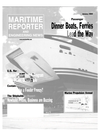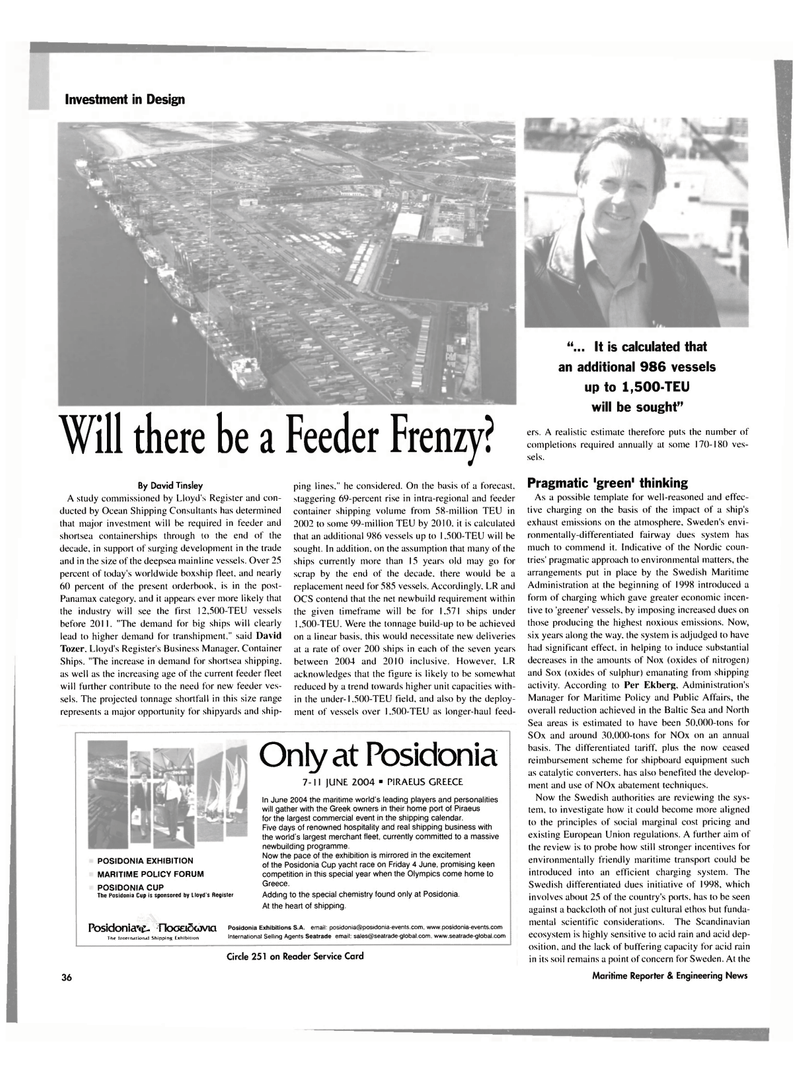
Page 36: of Maritime Reporter Magazine (January 2004)
Ferry & Passenger Vessel Yearbook
Read this page in Pdf, Flash or Html5 edition of January 2004 Maritime Reporter Magazine
Investment in Design
Will there be a Feeder Frenzy?
By David Tinsley
A study commissioned by Lloyd's Register and con- ducted by Ocean Shipping Consultants has determined that major investment will be required in feeder and shortsea containerships through to the end of the decade, in support of surging development in the trade and in the size of the deepsea mainline vessels. Over 25 percent of today's worldwide boxship fleet, and nearly 60 percent of the present orderbook, is in the post-
Panamax category, and it appears ever more likely that the industry will see the first 12,500-TEU vessels before 2011. "The demand for big ships will clearly lead to higher demand for transhipment." said David
Tozer. Lloyd's Register's Business Manager. Container
Ships. "The increase in demand for shortsea shipping, as well as the increasing age of the current feeder fleet will further contribute to the need for new feeder ves- sels. The projected tonnage shortfall in this size range represents a major opportunity for shipyards and ship- ping lines." he considered. On the basis of a forecast, staggering 69-percent rise in intra-regional and feeder container shipping volume from 58-million TEU in 2002 to some 99-million TEU by 2010. it is calculated that an additional 986 vessels up to 1.500-TEU will be sought. In addition, on the assumption that many of the ships currently more than 15 years old may go for scrap by the end of the decade, there would be a replacement need for 585 vessels. Accordingly. LR and
OCS contend that the net newbuild requirement within the given timeframe will be for 1.571 ships under 1,500-TEU. Were the tonnage build-up to be achieved on a linear basis, this would necessitate new deliveries at a rate of over 200 ships in each of the seven years between 2004 and 2010 inclusive. However, LR acknowledges that the figure is likely to be somewhat reduced by a trend towards higher unit capacities with- in the under-1.500-TEU field, and also by the deploy- ment of vessels over 1,500-TEU as longer-haul feed-
POSIDONIA EXHIBITION
MARITIME POLICY FORUM
POSIDONIA CUP
The Posidonia Cup is sponsored by Lloyd s Register
Only at Posidonia 7-11 JUNE 2004 PIRAEUS GREECE
In June 2004 the maritime world's leading players and personalities will gather with the Greek owners in their home port of Piraeus for the largest commercial event in the shipping calendar.
Five days of renowned hospitality and real shipping business with the world's largest merchant fleet, currently committed to a massive newbuilding programme.
Now the pace of the exhibition is mirrored in the excitement of the Posidonia Cup yacht race on Friday 4 June, promising keen competition in this special year when the Olympics come home to
Greece.
Adding to the special chemistry found only at Posidonia.
At the heart of shipping.
PosidoniaT4£- nooei3 The International Shipping Exhibition
Posidonia Exhibitions S.A. email: [email protected], www.posidonia-events.com
International Selling Agents Seatrade email: [email protected]. www.seatrade-global.com
Circle 251 on Reader Service Card
36
"... It is calculated that
an additional 986 vessels
up to 1,500-TEU
will be sought"
ers. A realistic estimate therefore puts the number of
completions required annually at some 170-180 ves-
sels.
Pragmatic 'green' thinking
As a possible template for well-reasoned and effec-
tive charging on the basis of the impact of a ship's
exhaust emissions on the atmosphere, Sweden's envi-
ronmentally-differentiated fairway dues system has
much to commend it. Indicative of the Nordic coun-
tries' pragmatic approach to environmental matters, the
arrangements put in place by the Swedish Maritime
Administration at the beginning of 1998 introduced a
form of charging which gave greater economic incen-
tive to 'greener' vessels, by imposing increased dues on
those producing the highest noxious emissions. Now,
six years along the way, the system is adjudged to have
had significant effect, in helping to induce substantial
decreases in the amounts of Nox (oxides of nitrogen)
and Sox (oxides of sulphur) emanating from shipping
activity. According to Per Ekberg, Administration's
Manager for Maritime Policy and Public Affairs, the
overall reduction achieved in the Baltic Sea and North
Sea areas is estimated to have been 50,000-tons for
SOx and around 30,000-tons for NOx on an annual
basis. The differentiated tariff, plus the now ceased
reimbursement scheme for shipboard equipment such
as catalytic converters, has also benefited the develop-
ment and use of NOx abatement techniques.
Now the Swedish authorities are reviewing the sys-
tem, to investigate how it could become more aligned
to the principles of social marginal cost pricing and
existing European Union regulations. A further aim of
the review is to probe how still stronger incentives for
environmentally friendly maritime transport could be
introduced into an efficient charging system. The
Swedish differentiated dues initiative of 1998, which
involves about 25 of the country's ports, has to be seen
against a backcloth of not just cultural ethos but funda-
mental scientific considerations. The Scandinavian
ecosystem is highly sensitive to acid rain and acid dep-
osition, and the lack of buffering capacity for acid rain
in its soil remains a point of concern for Sweden. At the
Maritime Reporter & Engineering News

 35
35

 37
37
